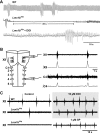The role of medullary serotonin (5-HT) neurons in respiratory control: contributions to eupneic ventilation, CO2 chemoreception, and thermoregulation
- PMID: 20133432
- PMCID: PMC2867541
- DOI: 10.1152/japplphysiol.01270.2009
The role of medullary serotonin (5-HT) neurons in respiratory control: contributions to eupneic ventilation, CO2 chemoreception, and thermoregulation
Abstract
The functional roles of the medullary raphé, and specifically 5-HT neurons, are not well understood. It has previously been stated that the role of 5-HT has been so difficult to understand, because "it is implicated in virtually everything, but responsible for nothing"(Cowen PJ. Foreword. In: Serotonin and Sleep: Molecular, Functional and Clinical Aspects, edited by Monti JM, Prandi-Perumal SR, Jacobs BL, Nutt DJ. Switzerland: Birkhauser, 2008). Are 5-HT neurons important, and can we assign a general, or even specific, function to them given their diffuse projections? Recent data obtained from transgenic animals and other model systems indicate that the 5-HT system is not expendable, particularly during postnatal development, and likely plays specific roles in vital functions such as respiratory and thermoregulatory control. We recently provided a detailed and updated review of one specific function of 5-HT neurons, as central respiratory chemoreceptors contributing to the brain's ability to detect changes in pH/CO2 and stimulate adjustments to ventilation accordingly (9). Here, we turn our focus to recent data demonstrating that 5-HT neurons provide an essential excitatory drive to the respiratory network. We then further discuss their role in the CO2 chemoreflex, as well as other homeostatic functions that are closely related to ventilatory control. Last, we provide additional hypotheses/concepts that are worthy of further study, and how 5-HT neurons may be involved in human disease.
Figures


Similar articles
-
Medullary serotonin neurons and central CO2 chemoreception.Respir Physiol Neurobiol. 2009 Aug 31;168(1-2):49-58. doi: 10.1016/j.resp.2009.04.014. Epub 2009 Apr 24. Respir Physiol Neurobiol. 2009. PMID: 19394450 Free PMC article. Review.
-
Ventilatory response to hypercapnia and hypoxia after extensive lesion of medullary serotonergic neurons in newborn conscious piglets.J Appl Physiol (1985). 2006 Oct;101(4):1177-88. doi: 10.1152/japplphysiol.00376.2006. Epub 2006 Jun 8. J Appl Physiol (1985). 2006. PMID: 16763104
-
Raphe magnus nucleus is involved in ventilatory but not hypothermic response to CO2.J Appl Physiol (1985). 2007 Nov;103(5):1780-8. doi: 10.1152/japplphysiol.00424.2007. Epub 2007 Sep 6. J Appl Physiol (1985). 2007. PMID: 17823301
-
Medullary 5-HT neurons: Switch from tonic respiratory drive to chemoreception during postnatal development.Neuroscience. 2017 Mar 6;344:1-14. doi: 10.1016/j.neuroscience.2016.09.002. Epub 2016 Sep 9. Neuroscience. 2017. PMID: 27619736 Free PMC article.
-
Medullary serotonin neurons and their roles in central respiratory chemoreception.Respir Physiol Neurobiol. 2010 Oct 31;173(3):256-63. doi: 10.1016/j.resp.2010.03.006. Epub 2010 Mar 10. Respir Physiol Neurobiol. 2010. PMID: 20226279 Free PMC article. Review.
Cited by
-
Focal microdialysis of CO₂ in the perifornical-hypothalamic area increases ventilation during wakefulness but not NREM sleep.Respir Physiol Neurobiol. 2013 Jan 15;185(2):349-55. doi: 10.1016/j.resp.2012.09.007. Epub 2012 Sep 19. Respir Physiol Neurobiol. 2013. PMID: 22999917 Free PMC article.
-
Revisiting the Role of Serotonin in Sleep-Disordered Breathing.Int J Mol Sci. 2024 Jan 25;25(3):1483. doi: 10.3390/ijms25031483. Int J Mol Sci. 2024. PMID: 38338762 Free PMC article. Review.
-
Respiration and autonomic regulation and orexin.Prog Brain Res. 2012;198:25-46. doi: 10.1016/B978-0-444-59489-1.00004-5. Prog Brain Res. 2012. PMID: 22813968 Free PMC article. Review.
-
A group of non-serotonergic cells is CO2-stimulated in the medullary raphé.Neuroscience. 2014 Feb 14;259:203-13. doi: 10.1016/j.neuroscience.2013.11.060. Epub 2013 Dec 10. Neuroscience. 2014. PMID: 24333211 Free PMC article.
-
Altered 5-HT2A/C receptor binding in the medulla oblongata in the sudden infant death syndrome (SIDS): Part I. Tissue-based evidence for serotonin receptor signaling abnormalities in cardiorespiratory- and arousal-related circuits.J Neuropathol Exp Neurol. 2023 May 25;82(6):467-482. doi: 10.1093/jnen/nlad030. J Neuropathol Exp Neurol. 2023. PMID: 37226597 Free PMC article.
References
-
- Aghajanian GK, Graham AW, Sheard MH. Serotonin-containing neurons in brain: depression of firing by monoamine oxidase inhibitors. Science 169: 1100–1102, 1970 - PubMed
-
- Audero E, Coppi E, Mlinar B, Rossetti T, Caprioli A, Banchaabouchi MA, Corradetti R, Gross C. Sporadic autonomic dysregulation and death associated with excessive serotonin autoinhibition. Science 321: 130–133, 2008 - PubMed
-
- Bernard DG, Li A, Nattie EE. Evidence for central chemoreception in the midline raphe. J Appl Physiol 80: 108–115, 1996 - PubMed
-
- Bradley SR, Pieribone VA, Wang W, Severson CA, Jacobs RA, Richerson GB. Chemosensitive serotonergic neurons are closely associated with large medullary arteries. Nat Neurosci 5: 401–402, 2002 - PubMed
Publication types
MeSH terms
Substances
LinkOut - more resources
Full Text Sources
Research Materials

